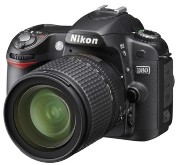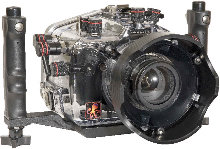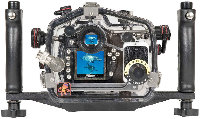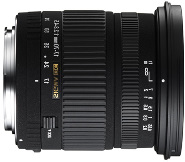Review of Nikon D80 and Ikelite housing
Published in Underwater Photography Magazine Issue 34
By Dave Harasti (www.daveharasti.com)
“It took four years for me to cave in but I finally succumbed and upgraded to a digital SLR. For the past couple of years my photography skills had been honed using the Nikon Coolpix 5000 and more recently the Coolpix 8400 and whilst I’ve managed to get a couple of decent shots out of both camera’s I had found the shutter lag to be extremely frustrating. This shutter lag has prevented me photographing many small fish species as all I ever ended up with was shots of their butt…”
The Camera
 The Nikon D80 was released in September 06 and is a 10.2 megapixel camera that sits on the Nikon digital SLR scale between the D70s and the D200. It utilises an image processing engine similar to the D200 / D2X and has a quoted 80 millisecond shutter lag. The large 2.5 inch LCD screen is fantastic to review images on and the D80 incorporates a new 11 area AF system that makes focusing your images all that much easier. The battery life for this camera is very impressive as it easily lasted 4 hours underwater and took over 300 photo’s without going flat. A 2gb SD card will give approximately 250 images whilst shooting the highest resolution jpeg or 130 in Nikon Raw (Nef) format.
The Nikon D80 was released in September 06 and is a 10.2 megapixel camera that sits on the Nikon digital SLR scale between the D70s and the D200. It utilises an image processing engine similar to the D200 / D2X and has a quoted 80 millisecond shutter lag. The large 2.5 inch LCD screen is fantastic to review images on and the D80 incorporates a new 11 area AF system that makes focusing your images all that much easier. The battery life for this camera is very impressive as it easily lasted 4 hours underwater and took over 300 photo’s without going flat. A 2gb SD card will give approximately 250 images whilst shooting the highest resolution jpeg or 130 in Nikon Raw (Nef) format.
The Housing
 I’m not sure how they managed to achieve it but Ikelite moved heaven and earth to have a housing designed, built and shipped to me in Australia within 1 month of them receiving the camera! It arrived a week before my research trip to Papua New Guinea which was to provide a perfect opportunity to give the camera and housing a good test run.
I’m not sure how they managed to achieve it but Ikelite moved heaven and earth to have a housing designed, built and shipped to me in Australia within 1 month of them receiving the camera! It arrived a week before my research trip to Papua New Guinea which was to provide a perfect opportunity to give the camera and housing a good test run.
The Ikelite D80 housing is surprisingly quite compact and as the D80 is slightly smaller than its Nikon ‘cousins’, Ikelite have ensured that the housing is also of minimal size. The D80 housing is slightly larger than my Coolpix 8400 housing and even manages to fit in the same travel bag. One major difference in travelling between the two camera’s is all the additional ports and lens that are required for the SLR; a drawback when it comes to flying! One excellent feature of the Ikelite housing is that the camera does not need to be removed from the tray to take out the battery or the SD memory card. This is very handy as it means you do not have to keep unscrewing the camera from Ikelite tray.
 The Ikelite housing provides full TTL functionality with digital strobes such as the Ikelite DS200, DS125 and DS51. The TTL system can only be described as sensational as it is very easy to change the strobe power output through the slight turn of the strobe control dial that is conveniently located on the back of the housing. With the simple turn of the dial, strobe power can be varied by four 1/3 f/stop increments over or under flash compensation, or seven manual power settings in half-stop increments.
The Ikelite housing provides full TTL functionality with digital strobes such as the Ikelite DS200, DS125 and DS51. The TTL system can only be described as sensational as it is very easy to change the strobe power output through the slight turn of the strobe control dial that is conveniently located on the back of the housing. With the simple turn of the dial, strobe power can be varied by four 1/3 f/stop increments over or under flash compensation, or seven manual power settings in half-stop increments.
The Ikelite housing allows control for all camera functions except the lock switch (which is not essential). Strobes are attached through the quick release handles that allow easy attachment and removal of strobe mounting arms at the touch of a button. One of the huge benefits of the Ikelite housing is that the clear polycarbonate material allows the photographer to check that the o-ring is sealed correctly. This is very important as it allows you to check if any sand, cable ties or other foreign matter are hindering the o-ring seal. The housing is also rated to a depth of 60 metres which is more than enough for most divers!
Lens Selection
 The Ikelite housing allows use of most macro, wide angle, and zoom lenses through the use of flat and dome ports and the new ‘Super Huge’ 8 inch dome port. The 8 inch port is fantastic for use with the Nikon 10.5mm fisheye and the Nikon 12-24mm zoom lens; this port also makes under/over shots much easier to take. Another ideal lens for consideration is the Sigma 17-70mm macro zoom lens; this lens was used on a recent trip to Papua New Guinea and proved to be very successful behind the 8 inch dome port. On the single dive I was able to take wide angle reef shots and then was able to zoom in nice and close on nudibranchs only 2cm long – the lens is incredibly versatile. My preferred lens for macro and fish portraits is the Nikon 60mm which works very well with dual strobes in TTL mode.
The Ikelite housing allows use of most macro, wide angle, and zoom lenses through the use of flat and dome ports and the new ‘Super Huge’ 8 inch dome port. The 8 inch port is fantastic for use with the Nikon 10.5mm fisheye and the Nikon 12-24mm zoom lens; this port also makes under/over shots much easier to take. Another ideal lens for consideration is the Sigma 17-70mm macro zoom lens; this lens was used on a recent trip to Papua New Guinea and proved to be very successful behind the 8 inch dome port. On the single dive I was able to take wide angle reef shots and then was able to zoom in nice and close on nudibranchs only 2cm long – the lens is incredibly versatile. My preferred lens for macro and fish portraits is the Nikon 60mm which works very well with dual strobes in TTL mode.
For further information on the Ikelite D80 housing and Ikelite port systems visit the Ikelite website at www.ikelite.com
Back
to Articles
 The Nikon D80 was released in September 06 and is a 10.2 megapixel camera that sits on the Nikon digital SLR scale between the D70s and the D200. It utilises an image processing engine similar to the D200 / D2X and has a quoted 80 millisecond shutter lag. The large 2.5 inch LCD screen is fantastic to review images on and the D80 incorporates a new 11 area AF system that makes focusing your images all that much easier. The battery life for this camera is very impressive as it easily lasted 4 hours underwater and took over 300 photo’s without going flat. A 2gb SD card will give approximately 250 images whilst shooting the highest resolution jpeg or 130 in Nikon Raw (Nef) format.
The Nikon D80 was released in September 06 and is a 10.2 megapixel camera that sits on the Nikon digital SLR scale between the D70s and the D200. It utilises an image processing engine similar to the D200 / D2X and has a quoted 80 millisecond shutter lag. The large 2.5 inch LCD screen is fantastic to review images on and the D80 incorporates a new 11 area AF system that makes focusing your images all that much easier. The battery life for this camera is very impressive as it easily lasted 4 hours underwater and took over 300 photo’s without going flat. A 2gb SD card will give approximately 250 images whilst shooting the highest resolution jpeg or 130 in Nikon Raw (Nef) format. I’m not sure how they managed to achieve it but Ikelite moved heaven and earth to have a housing designed, built and shipped to me in Australia within 1 month of them receiving the camera! It arrived a week before my research trip to Papua New Guinea which was to provide a perfect opportunity to give the camera and housing a good test run.
I’m not sure how they managed to achieve it but Ikelite moved heaven and earth to have a housing designed, built and shipped to me in Australia within 1 month of them receiving the camera! It arrived a week before my research trip to Papua New Guinea which was to provide a perfect opportunity to give the camera and housing a good test run. The Ikelite housing provides full TTL functionality with digital strobes such as the Ikelite DS200, DS125 and DS51. The TTL system can only be described as sensational as it is very easy to change the strobe power output through the slight turn of the strobe control dial that is conveniently located on the back of the housing. With the simple turn of the dial, strobe power can be varied by four 1/3 f/stop increments over or under flash compensation, or seven manual power settings in half-stop increments.
The Ikelite housing provides full TTL functionality with digital strobes such as the Ikelite DS200, DS125 and DS51. The TTL system can only be described as sensational as it is very easy to change the strobe power output through the slight turn of the strobe control dial that is conveniently located on the back of the housing. With the simple turn of the dial, strobe power can be varied by four 1/3 f/stop increments over or under flash compensation, or seven manual power settings in half-stop increments.  The Ikelite housing allows use of most macro, wide angle, and zoom lenses through the use of flat and dome ports and the new ‘Super Huge’ 8 inch dome port. The 8 inch port is fantastic for use with the Nikon 10.5mm fisheye and the Nikon 12-24mm zoom lens; this port also makes under/over shots much easier to take. Another ideal lens for consideration is the Sigma 17-70mm macro zoom lens; this lens was used on a recent trip to Papua New Guinea and proved to be very successful behind the 8 inch dome port. On the single dive I was able to take wide angle reef shots and then was able to zoom in nice and close on nudibranchs only 2cm long – the lens is incredibly versatile. My preferred lens for macro and fish portraits is the Nikon 60mm which works very well with dual strobes in TTL mode.
The Ikelite housing allows use of most macro, wide angle, and zoom lenses through the use of flat and dome ports and the new ‘Super Huge’ 8 inch dome port. The 8 inch port is fantastic for use with the Nikon 10.5mm fisheye and the Nikon 12-24mm zoom lens; this port also makes under/over shots much easier to take. Another ideal lens for consideration is the Sigma 17-70mm macro zoom lens; this lens was used on a recent trip to Papua New Guinea and proved to be very successful behind the 8 inch dome port. On the single dive I was able to take wide angle reef shots and then was able to zoom in nice and close on nudibranchs only 2cm long – the lens is incredibly versatile. My preferred lens for macro and fish portraits is the Nikon 60mm which works very well with dual strobes in TTL mode.